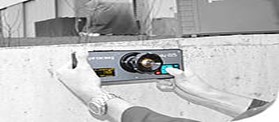
STRUCTURAL EVALUATION & STRUCTRUAL HEALTH MONITORING
Structural evaluation is the process of determining the structural adequacy of buildings and other structures or components according to their intended use. Structural evaluations may be conducted for a variety of reasons which include, but are not limited to, investigation of failures, code conformance, durability, preservation, and repair.
WES employs a number of experienced staff able to identify critical structural parameters and properties which require the use of both destructive and non-destructive sampling and testing to obtain the necessary data. These include:
- Verification and identification of current geometry and member sizes
- Assessment of damage caused by corrosion
- Location of hidden flaws and defects (voids, trapped moisture, poor consolidation, etc.)
- Determination of the properties of the concrete
- Determination of the properties of the reinforcing steel.


Non-destructive testing (NDT) is the process of inspecting, testing, or evaluating materials, components or assemblies for discontinuities, or differences in characteristics without destroying the serviceability of the part or system, so that when the inspection or test has been completed, the component can still be used.
In contrast to NDT, other tests are destructive in nature, and are therefore carried out on a limited number of samples (“lot sampling”), rather than on the materials, components or assemblies actually being put into service.
These destructive tests are often used to determine the physical properties of materials, such as impact resistance, ductility, yield and ultimate tensile strength, fracture toughness and fatigue strength: however, discontinuities and differences in material characteristics are more effectively found by NDT.
Structural Evaluation Testing performed by WES includes:
- Non-destructive testing and estimation of concrete compressive strength using the Schmidt Hammer test.
- Compressive Strength of concrete cores.
- Measurement of concrete cover
- Ultrasonic Pulse Velocity
- Ultrasonic Pulse Echo
- Tensile Strength of Reinforcing bars
- Cracks Mapping
- Permeability Test for Concrete
Structural Health Monitoring involves the observation of a structure over time using periodically spaced measurements, the extraction of damage-sensitive features from these measurements, and the statistical analysis of these features to determine the current state of system health.
WES capability includes a team of staff experienced in Structural Health Monitoring, capable of deploying a variety of measuring sensors including Strain Gauges, LVDTs, Linear Potentiometers for displacement, Thermocouples, crack sensors, Resistance Temperature Detectors (RTD), and piezoelectric accelerometers, using Data Loggers and Data Acquisition Systems to collect, save and process the collected data.
